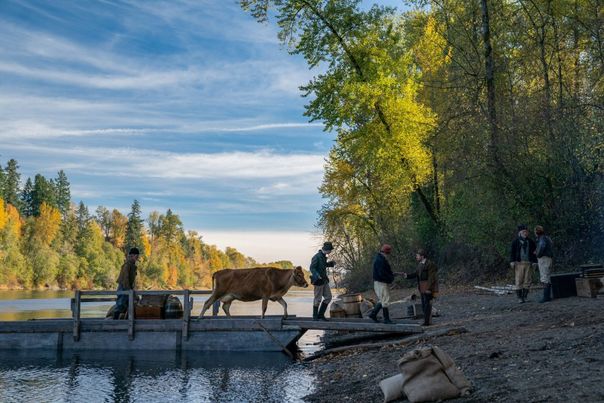Friendship That Sticks
The world of First Cow is one of enmeshed existences, where solidarity to the other, human or nonhuman, is the key virtue
By Savina Petkova

© Allyson Riggs/A24
At first, fingers slide into wet soil to unearth human bones. A little later, another hand picks up a lizard stuck on its back to reanimate it; that same night, a hand wraps a blanket around a sleeping body. Intimacy of man, animal, and nature permeate Kelly Reichardt’s sensory rich FIRST COW (USA). After its premiere at Telluride, critics have doubled Reichardt’s Berlinale Competition entry up with the contemplative director’s 2006 ode to friendship OLD JOY. Also set in Oregon, this time in early 19th century, FIRST COW follows Cookie Figowitz (a seraphic John Magaro) team up with King Lu (Orion Lee) in an affectionate bond based on the shared strive for easy fortune. With persistent tenderness, the film’s haptic visuals and sound affect the spectator in a multi-sensory way, and one cannot help but feel (and feel a lot) for those small-time cons, also testifying to Reichardt’s command of ethics and political undertones.
The film’s aesthetics embody both the serenity and the suspense of the unfolding human relationships, captured brilliantly by longer, static takes. Together with the abundance of close-ups representing touch, the glowing warmth of its yellow and ochre palette beckons the viewer to come nearer still. On the other hand, William Tyler’s tender score mingles with amplified natural sounds of fruit picking or mushroom plucking to elicit a palpable, bodily reaction – intensified, the noises allude to taste, smell, and texture. The consistent use of close-ups by Reichardt’s regular cinematographer Christopher Blauvelt is both decisive and intimate, as hands are framed milking, kneading, or squeezing a ladder so a friend does not fall off it. A door and a window provide a split-screen effect as King Lu cuts up wood and Cookie tidies up a home that’s not his: they are, indeed, nesting. Home, or the lack thereof, seems to unite both men as a traveler and immigrant, so it comes as no surprise when their fortune plan to sell handmade oily cakes at the market prospers greatly. The secret ingredient, milk, is also alluded to be “a little taste of home”, furthering the recurring motif of togetherness against all odds.
In a spectacular long take the camera floats along tracking a raft that turns all the heads of the town, and the epicenter of attention is not the rowing human, but the titular first cow in the land. The foreign creature’s bovine beauty is emphasized through faint glimmers of golden light that make its silhouette glow. What can be considered somewhat beatific, the filmmaker’s attention to the animal is as far from fetishism as it can get. Reichardt is conscious of the risk of paring down animals to metaphors and instead pays homage to them precisely as nonhuman animals. Cookie addresses the cow while he milks it, and after a while the caring timbre of his whisper is rewarded with reciprocal signs of attention from the animal in one of the film’s points of tension. Solidarity and attentiveness to the other, be it human or nonhuman, is the key virtue one should take away from this film. The world of FIRST COW is one of enmeshed existences, as the opening quote by William Blake reads over the screen’s blackness: “The bird a nest, the spider a web, man friendship”.

